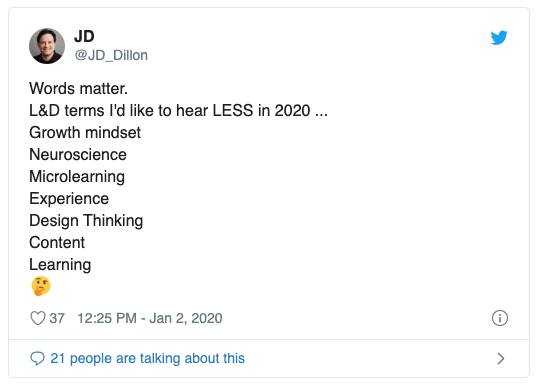I shared this tweet a few days ago …

It started a fun online conversation … that’s still going. So I figured it would be worth expanding upon, beyond the limited context of a 135-character tweet.
Words matter.
Terminology is an important part of any profession. It’s a common language. It’s a foundation on top of which unique, contextual ideas can be built. If you don’t have a basic language within a professional community, you waste a lot of time and effort re-explaining the basics to people who should be the experts.
We have always had this problem in L&D. Everyone’s favorite example from the past few years: microlearning. I have a definition, but I’m sure it includes elements that aren’t part of your definition. This may be perfectly fine. Or it may create unnecessary distractions, as has clearly been the case with microlearning.
The function of L&D varies considerably between organizations. This isn’t surprising. After all, everyone in the company seems to have an opinion on what “learning” should mean based on their past experiences. But within this challenging variability, we are too often inconsistent in the way we discuss, explain and execute our practices.
L&D terms I’d like to hear LESS in 2020 …
A few of the terms on my not-at-all-comprehensive list should go away completely. Most of them should stay. But they should all be used less to some degree. Like any other L&D term, these should be used consistently and with purpose, not thrown around without a clear meaning in order to make a concept or product sound like something that it’s not.
Growth mindset
People need help identifying growth opportunities. They should be engaged in continuous conversation and development. Otherwise, they may become locked in their way of thinking and struggle to adapt to change. I’m sorry, but this is common sense. We just never thought about it until the topic became trendy. Eventually, we’ll bemoan the time, effort and resources spent on mindset training in the same way we’re starting to with Myers-Briggs and DiSC.
Neuroscience
By definition, neuroscience is the biological study of the nervous system: brain, spinal cord, neurons, etc. This doesn’t have anything to do with the operational side of learning. L&D can’t really make use of the limited scientific research available on this topic. If someone is trying to sell you an approach or technology based on the “latest discoveries in neuroscience,” they are either pushing junk or using the wrong terminology, which should also make you suspicious. Cognitive science, learning science, psychology … these terms are more appropriate for what L&D does every day because they focus on the mind and its processes.
Microlearning
Are we finished with this one yet? The term doesn’t really mean anything. Also, “macrolearning” shouldn’t be a real word either. For the past several years, my teams have engaged directly in the microlearning conversation. We met the trend head-on and have tried to help L&D pros focus on proven principles, not buzz and hype. We’ve been pretty successful within our audience and are now starting to shift away from the term, as should the rest of the industry.
Experience
This is a good term. I like this term. It speaks to the holistic nature of development. It’s not about content. It’s about the overall experience of learning and working. However, we have started attaching this word to everything. Example: learning experience platform. What exactly is the “experience” within this tech category that meaningfully differentiates it from an LMS? I would like to see a more consistent definition for “learning experience” emerge. It can then be used to guide solution development. Of course, the actual experience will vary based on context.
Design thinking
Again, another good term. However, it is too often applied without the necessary rigor. “Design thinking” seems to have replaced “design,” but without any meaningful change in process. I am by no means an expert in this topic. Instead, here’s an article from Becca Wilson. This is what I expect to hear when L&D pros discuss how design thinking is impacting their practices. While I come across the term a lot, I don’t hear this depth all that often.
Content
Content is an important part of what we do. It comes in all shapes and sizes. We need it. Content just shouldn’t be the centerpiece of our workplace learning strategy. It shouldn’t be the default solution. L&D should be more focused on establishing channels and connections and less focused on building things.
Learning
We use this term for everything nowadays. Content is learning. Training is learning. Our teams are learning. At some point, “training” became a bad word, so we replaced it with “learning.” Our job isn’t to help people learn. It’s to help people accomplish their goals. Learning is naturally a big part of that, but it’s not the goal. Also, “learning” is a very complex, personal process, not the stuff we build to help people execute that process.
Soft skills
This should have been in my original Twitter list. Anyway, a skill is a skill. Some are more challenging to develop. Some are more difficult to define and measure. We don’t need the extra classifier.
A few terms I’d like to hear more …
- Help: If I could make universal decisions, I would change the name “L&D” to “Help” because that’s what we should be doing … helping people do their jobs better regardless of what it requires from us.
- Solve: L&D should be focused on helping organizations solve problems through their people. Learning is a big part of this but not the end goal.
- Connect: So many problems may go away if people could more quickly and easily connect with others who have the necessary knowledge and experience. This is what “social learning” could be, but it takes more than content and platforms.
- Share: L&D plays middleman too much. We have to find ways to motivate and enable people to share their knowledge and experience without requiring our limited capacity and resources.
- Practice: Would anyone argue against the value of more purposeful practice? L&D should find new ways to help employees practice (reinforce, reflect, apply, etc.) amid their day-to-day responsibilities.
- Impact: L&D measurement is broken. If we cannot determine how our efforts are (or are not) impacting organizational and individual results, then what’s the point?
- Work: People don’t go to work to learn. They go to do the job. Development should be part of that job, not an add-on that is rarely prioritized.
- Train: Why is this a bad word? Training is good. People benefit from training … when it’s the appropriate solution.
Am I generalizing my critique of industry terminology? Yes.
Am I an expert in everything L&D? No.
Are my generalizations based on hundreds of conversations with L&D pros around the world as well as years of practical experience? Yes.
Should I be the only voice in this conversation? Not at all!
No one can speak for an entire industry, regardless of how many Twitter followers you have or articles you write. But, sometimes a purposefully-prickly observation can be useful when it starts a valuable conversation. Otherwise, nothing will change.
That’s 7272 characters to explain a 135-character tweet. 🙂



